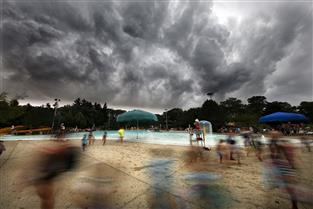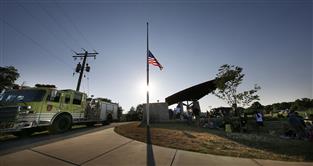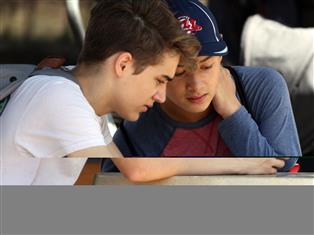Flight for Life emergency pilots rely on instinct, experience
Flying helicopters and saving lives isn't an entry-level type job.
It takes a minimum of 2,000 hours in the skies, years of experience and an instinct for safety to fly a Flight for Life helicopter, rescue pilots Vince Freeborn and Clark Richards said. While there are strict standards they must adhere to, and although each flight is for a patient in dire need, both men say they have an itch to fly and love their jobs.
Those living near Froedtert Hospital hear the hum of their helicopter frequently, as it brings in critically injured people for emergency care.
Earning the part
According to Freeborn and Richards, two paths lead to becoming a pilot. One path is through years of experience in the civilian world and the other is through years of experience flying military helicopters.
Having grown up around helicopters, Richards took the civilian route. He earned his pilot's license at the youngest age possible, 16. He went to an aviation-related college and spent as much time in the air as he could, flying on the weekends and working on extra certificates.
"The key in the civilian world is getting enough experience to work a job when you don't really have the experience," he said. "It's the chicken and the egg thing. You basically have to beg, borrow and steal. I flight instructed and did whatever I could to get the flight time I needed to get my first job."
He landed that position in 1986, although it was a slightly less glamorous gig flying a traffic-spotting helicopter. It served as his foot in the hangar door. He didn't become an emergency medical service pilot until 2007.
Freeborn took the military route, flying attack helicopters for the Army and for a United Nations-contracted group. He flew in Cambodia, Mozambique and Hawaii and was a flight instructor in Alabama before landing a job as an EMS pilot.
Listening to their guts
The two pilots can put down the twin-engine Eurocopter EC145 and the MBB/Kawasaki BK 117 helicopters in any 150-square-foot area on a dark night.
That doesn't mean that they will.
Saying the hardest part of his job is turning down a rescue call, Freeborn explained, "Anybody can say yes, they're going to take any flight that comes in, no matter the weather or where they want us to land. We can do that, sure. We're going to crash helicopters, kill people and damage property if we do that."
Before a pilot takes a call, they have to factor in what the weather is going to do, where they're going to land and if they're going to go above their maximum number of allowed hours in a day.
A pilot has to predict how the weather is going to change. Freeborn said he will cancel a flight, even if the weather is trending toward calm, if his instincts tell him a storm is coming.
"So many times, within a half hour, it's like, thank God we're sitting on the ground wishing we were in the air verses being in the air wishing we were on the ground," he said.
Once the call has been taken and they're moving to the scene of an accident, the pilots have to think about not only the square they will land on, but what's around it. If there are tents, snow or people near the landing zone, the pilot may choose to land farther from the accident.
"You name it, we've probably landed there," Freeborn said. "It's a matter of 'Can we go somewhere legally and safely?'"
Business in the skies
Besides saying "no" to a call, another hard aspect for the pilots is keeping emotions on the ground.
Richards makes it a point not to look his patient in the eyes, know as little about the patient as possible and keep his mind on flying the helicopter.
"You do care, but I try to back myself from that. I'm trying to disconnect that temptation to cheat the rule or go (fly) where you shouldn't be going or that sort of thing. I have pretty good discipline around that, and it helps me," he said.
Sometimes, however, the weight of what he does catches up to Richards. At events, patients will sometimes come up to him and thank him for saving their lives. Saying that he remembers some of the ones who thanked him, he added, "It's those kinds of events where it circles right back home, and you get it.
For Freeborn, one flight in particular sticks out.
He had recently moved to Mukwonago after being hired by Flight for Life, and was shopping at Walmart with an EMT nurse. Both were clad in their flight suits.
His cashier, an older teenager, profusely thanked him. She had a tracheotomy scar and said she had gotten in a nasty accident a while back and was saved by a Flight for Life pilot.
The next day, while on a flight, Freeborn landed away from an accident at a church parking lot. An ambulance took the helicopter's medical staff to the scene.
They weren't needed.
On the flight back, the ambulance staff commented that Walmart would be missing a cashier, and how odd it was that she had a tracheotomy scar. Freeborn described the cashier that had checked him out the day before and found out the woman thanking him one day was the woman who didn't make it the next.
"That flight, coming back, got very quiet," he said. "I probably didn't have a lot to say the rest of the day."
An itch to fly
Despite everything — the requirements to fly, the nature of the calls and having to turn calls down — both pilots say flying is addicting.
"My job is to fly the aircraft," Richards said. "I want to do my job. I can only do so much paperwork. I can only yak it up in the hangar for so long. I want to fly."
Freeborn agreed, saying that he gets cranky when he hasn't been in the air for a few days.
"For me, now, when I get in the aircraft, it's almost like experiencing it all over again for the first time," he said. "We're not doing this as a joyride, even though we love doing what we do. When we fly there's somebody that needs us."
More from News and Features
- Anodyne Coffee plans to open location in Wauwatosa Village
- Wauwatosa Meetings: Aug. 4
- Video: Wauwatosa girl's curbside ice cream stand raises money for the hungry
- Wauwatosa News and Notes: Hands-only CPR training offered; Firefly Art Fair is Aug. 6-7
- Wauwatosa Ask Now: Why are there barriers and fencing along the North Avenue bridges over the Menomonee River?
- Mystery Photo Contest: July 28
- Wauwatosa gears up for National Night Out event, this year at the zoo
- Election 2016: Wisconsin's 4th District candidates weigh in
- Wauwatosa's Luther Manor residents share smiles through flower delivery
- Wauwatosa Police Report: July 17-23















